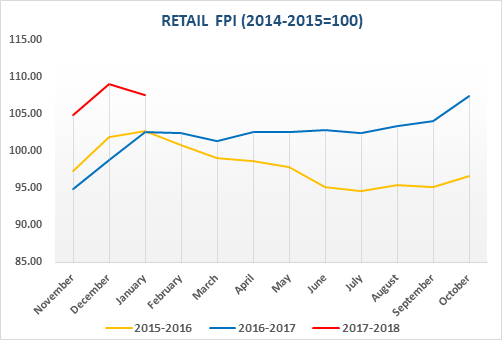Indexes
 01
February
2018
01
February
2018

 01
February
2018
01
February
2018
At the end of January, ISET’s Retail Food Price Index increased by 5.2% y/y (compared to January 2017). On a monthly basis (compared to December 2017), food prices in Tbilisi’s major supermarkets decreased slightly by 0.3%. According to data from the last two weeks of January, prices dropped the most for buckwheat (-6%), rice (-6%), and bananas (-2%). Among the sharpest price increases was an 8% rise in the price of wheat flour and tangerines, while milk and frozen chicken climbed 3%.
ISET’s Retail FPI ended a year on a high note: retail food prices picked up in December 2017, showed a significant rise of 10% year-on-year, and had the highest reading in three years (since the Index was launched in November 2014). After facing expensive Christmas dinners, Georgian consumers might be relieved as food inflation cooled to 5.2% in January 2018 (compared to January 2017).

International prices also exhibited an upward trend in 2017. The Food Price Index, measured by the Food and Agriculture Organization (FAO), showed a significant 8.2% hike in 2017, compared to the previous year. According to FAO, this was the highest annual average record since 2014. The main drivers were meat and dairy prices. In 2017, the FAO Meat Price Index gained 9% from 2016, while the FAO Dairy Price Index showed the sharpest increase at 31.5%. Reflecting international prices, meat and dairy products have become more expensive in Tbilisi’s retail supermarkets. Prices increased the most for beef (20% ↑), butter (17% ↑), cheese (16% ↑), and milk (7% ↑).
According to the World Bank, food prices are expected to increase further in 2018. This might be welcome news for producers and the food industry, but not so much for budget-conscious consumers.





